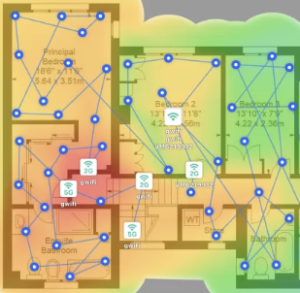It’s easy, right? Buy your devices, configure them, hang them up where you think they should go, and all should be good. I wish it were that easy and it sure would save everyone money through engineering time and end-user cost.
But I’ve got a better idea. Let’s do it the right way….
Assessing Your Needs and Environment for a Network Wireless Solution
Determine the goal and areas for the wireless coverage. How many users and devices will depend on the solution? Are there any likely dead zones? Where are the high-use zones? What is the material composition of the floors, walls, ceilings, door types, and other potential obstacles? Are there areas that do not need to be covered?
Lastly, can a wired solution be used versus a wireless solution as wired connectivity is better throughput with a more predictable outcome. From all these questions, you may not need a wireless solution; rather, you may need a wired solution. For the sake of this article, a wireless solution has been determined to be the best course of action.
Planning Your Business Wireless Network Design
Locate the facility Master Data Frame (MDF) or equivalent. Is it centralized? Does it have the capacity to house additional equip ment? Will you need Intermediate Data Frames (IDFs) to properly deploy the solution based on the size of the facility. Perform a walkthrough of the facility to include poking your head into the ceiling areas so that you understand the signal bleed. From your assessment of the material composition, and all other key points, you are ready for the design.
ment? Will you need Intermediate Data Frames (IDFs) to properly deploy the solution based on the size of the facility. Perform a walkthrough of the facility to include poking your head into the ceiling areas so that you understand the signal bleed. From your assessment of the material composition, and all other key points, you are ready for the design.
Ignite your heat map, calibrate the distances, insert the material compositions, and start laying in your Wireless Access Points (WAPs). The heat map will provide you with a wealth of information to properly design the wireless network with the proper coverage and overlap. Generate your E-Plane and H-Plane design output and you are ready for the next steps.
Supporting Network Equipment for Your Wireless Solution
What is controlling the wireless? Will you plug your WAPs into traditional power sources or will you be using Power-Over-Ethernet (POE) services. Do your switches have enough POE budget to power the WAPs? Did you design for expansion? Now that we have all these questions answered, your wireless design and deployment is ready.
Why Proper Wireless Network Design Matters
It’s Easy, Right? And back to the first sentence of the first paragraph we arrive. There is more to simply hanging up WAPs to properly design a wireless network. Understanding all the checkpoints noted above is critical to the design. And when you go through all these checkpoints, you can be sure you have the right solution for your business.
If you are considering a wireless solution for your business, contact Ion Technology Group. Do not leave your business to chance by simply hanging WAPs and wondering why its not working as you thought. Ion has been performing wireless designs for decades and can help you. Call 1.856.719.1818 to start your discussions today.




